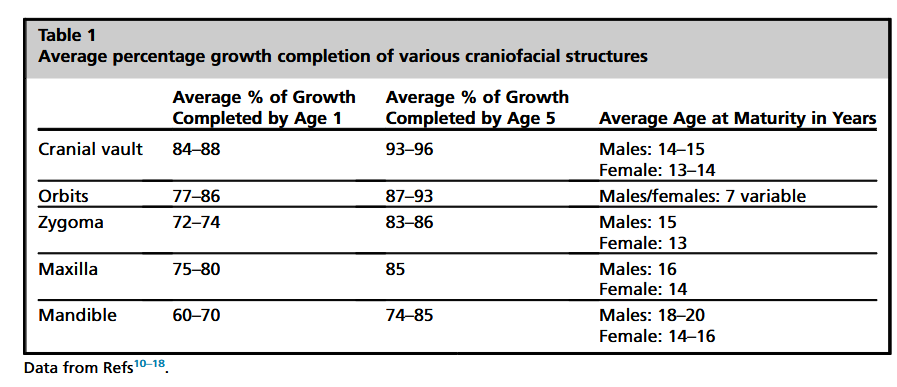I
idkmanimao
1g test, 10 ui's gh 𝐂𝐀𝐈 𝐂𝐫𝐞𝐰 𝐌𝐞𝐦𝐛𝐞𝐫
- Joined
- Feb 20, 2025
- Posts
- 8,315
- Reputation
- 12,217
Bone growth during childhood and puberty follows a very precise biological schedule, and different craniofacial structures mature at very different rates. Studies measuring thousands of skulls and facial bones across ages have shown that the cranial vault is already over eighty percent of its adult size by the first year of life and reaches more than ninety percent by age five. The orbits, which house the eyes, follow a similar trajectory, nearing full size extremely early. The zygomatic bones, which shape the cheeks, are already more than seventy percent developed by age one and over eighty percent by the start of school. The maxilla completes the majority of its growth before the mid teen years, while the mandible is one of the last bones to mature, often continuing subtle changes until the late teens or even around twenty years of age in some cases. These numbers show how much of the face’s foundation is already laid before puberty even begins.
During puberty itself, growth is heavily influenced by a surge of sex hormones like testosterone and estrogen, as well as growth hormone and IGF-1. These hormones interact with growth plates, sutures, and cartilage in ways that can accelerate certain changes. In the mandible, for example, the condylar cartilage responds to these hormonal signals by adding new bone, which is why jaw length and prominence can noticeably increase during the teenage years. The zygoma and maxilla can also gain some additional projection or thickness in this phase, though the changes tend to be smaller compared to earlier childhood. Even the cranial vault and orbits, while mostly complete in size, may undergo slight shape refinements as surrounding soft tissues and muscles develop.
Compounds that mimic or enhance these hormonal effects have been studied in controlled medical contexts, mostly for children with growth disorders. Growth hormone therapy can boost linear growth in certain bones if growth centers are still active, while PTH analogs like teriparatide can increase bone formation rates. Testosterone in normal pubertal doses during adolescence contributes to both bone lengthening and density increases, especially in males, while estrogen plays a key role in closing the growth plates at the end of puberty. The outcome depends heavily on timing if the compound is acting while a structure’s growth potential remains, the changes can be more pronounced, whereas if most growth is complete for that structure, the effects are more about density and minor contour adjustments rather than large dimensional shifts.
The data in those growth percentage charts shouldn’t be read as exact limits for every individual, but rather as a general guide to when most growth has occurred. Puberty is a period of both completion and refinement in bone development. The earlier a structure matures, the less dramatic the changes will be during the teen years, while later maturing structures like the mandible can still undergo visible transformation before reaching full skeletal maturity. The interaction between genetic timing, hormonal environment, and possible medical interventions ultimately determines how much change is.
TL: DR
Most craniofacial bones are already mostly grown before puberty, with the cranial vault, orbits, and zygos largely shaped by early childhood
 . Puberty still brings hormonal surges that can change later maturing bones like the mandible and can increase density and contour shifts. Compounds like growth hormone, testosterone, and PTH analogs can enhance growth if the growth centers are still active, but their effect depends heavily on timing and the natural maturity schedule of each bone. Not to mention this is really dependent on someone's hormones and reaction which is rare ofc.
. Puberty still brings hormonal surges that can change later maturing bones like the mandible and can increase density and contour shifts. Compounds like growth hormone, testosterone, and PTH analogs can enhance growth if the growth centers are still active, but their effect depends heavily on timing and the natural maturity schedule of each bone. Not to mention this is really dependent on someone's hormones and reaction which is rare ofc.

@Copercel @Mainlander @Volksstaffel @HighIQ ubermensch GTFIH
During puberty itself, growth is heavily influenced by a surge of sex hormones like testosterone and estrogen, as well as growth hormone and IGF-1. These hormones interact with growth plates, sutures, and cartilage in ways that can accelerate certain changes. In the mandible, for example, the condylar cartilage responds to these hormonal signals by adding new bone, which is why jaw length and prominence can noticeably increase during the teenage years. The zygoma and maxilla can also gain some additional projection or thickness in this phase, though the changes tend to be smaller compared to earlier childhood. Even the cranial vault and orbits, while mostly complete in size, may undergo slight shape refinements as surrounding soft tissues and muscles develop.
Compounds that mimic or enhance these hormonal effects have been studied in controlled medical contexts, mostly for children with growth disorders. Growth hormone therapy can boost linear growth in certain bones if growth centers are still active, while PTH analogs like teriparatide can increase bone formation rates. Testosterone in normal pubertal doses during adolescence contributes to both bone lengthening and density increases, especially in males, while estrogen plays a key role in closing the growth plates at the end of puberty. The outcome depends heavily on timing if the compound is acting while a structure’s growth potential remains, the changes can be more pronounced, whereas if most growth is complete for that structure, the effects are more about density and minor contour adjustments rather than large dimensional shifts.
The data in those growth percentage charts shouldn’t be read as exact limits for every individual, but rather as a general guide to when most growth has occurred. Puberty is a period of both completion and refinement in bone development. The earlier a structure matures, the less dramatic the changes will be during the teen years, while later maturing structures like the mandible can still undergo visible transformation before reaching full skeletal maturity. The interaction between genetic timing, hormonal environment, and possible medical interventions ultimately determines how much change is.
TL: DR
Most craniofacial bones are already mostly grown before puberty, with the cranial vault, orbits, and zygos largely shaped by early childhood

@Copercel @Mainlander @Volksstaffel @HighIQ ubermensch GTFIH



